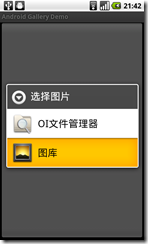編輯:關於Android編程
A. setVolumeControlStream(AudioManager.STREAM_MUSIC);
t)
public final void setVolumeControlStream (int streamType)
Added in API level 1
Suggests an audio stream whose volume should be changed by the hardware volume controls.
The suggested audio stream will be tied to the window of this Activity. Volume requests which are received while the Activity is in the
foreground will affect this stream.
It is not guaranteed that the hardware volume controls will always change this stream's volume (for example, if a call is in progress, its
stream's volume may be changed instead). To reset back to the default, use USE_DEFAULT_STREAM_TYPE.
Parameters
streamType
The type of the audio stream whose volume should be changed by the hardware volume controls.
AudioManager的值:http://developer.android.com/reference/android/media/AudioManager.html
int STREAM_MUSIC The audio stream for music playback
B.getAssets ()
http://developer.android.com/reference/android/content/res/Resources.html#getAssets()
public final AssetManager getAssets ()
Added in API level 1
Retrieve underlying AssetManager storage for these resources.
C.AssetManager
http://developer.android.com/reference/android/content/res/AssetManager.html
D.AssetFileDescriptor
http://developer.android.com/reference/android/content/res/AssetFileDescriptor.html
E.SoundPool
http://developer.android.com/reference/android/media/SoundPool.html
The SoundPool class manages and plays audio resources for applications.
A SoundPool is a collection of samples that can be loaded into memory from a resource inside the APK or from a file in the file system. The
SoundPool library uses the MediaPlayer service to decode the audio into a raw 16-bit PCM mono or stereo stream. This allows applications to
ship with compressed streams without having to suffer the CPU load and latency of decompressing during playback.
http://developer.android.com/reference/android/media/SoundPool.html#SoundPool(int, int, int)
Parameters
maxStreams
the maximum number of simultaneous streams for this SoundPool object
streamType
the audio stream type as described in AudioManager For example, game applications will normally use STREAM_MUSIC.
srcQuality
the sample-rate converter quality. Currently has no effect. Use 0 for the default.
Returns
a SoundPool object, or null if creation failed
F.MediaPlayer
http://developer.android.com/reference/android/media/MediaPlayer.html
G.MediaPlayer.OnCompletionListener
http://developer.android.com/reference/android/media/MediaPlayer.OnCompletionListener.html
package com.badlogic.androidgames.framework;
public interface Sound {
public void play(float volume);
public void dispose();
}
package com.badlogic.androidgames.framework;
public interface Music {
public void play();
public void stop();
public void pause();
public void setLooping(boolean looping);
public void setVolume(float volume);
public boolean isPlaying();
public boolean isStopped();
public boolean isLooping();
public void dispose();
}
package com.badlogic.androidgames.framework;
public interface Audio {
public Music newMusic(String filename);
public Sound newSound(String filename);
}
package com.badlogic.androidgames.framework.impl;
import java.io.IOException;
import android.content.res.AssetFileDescriptor;
import android.media.MediaPlayer;
import android.media.MediaPlayer.OnCompletionListener;
import com.badlogic.androidgames.framework.Music;
public class AndroidMusic implements Music, OnCompletionListener {
MediaPlayer mediaPlayer;
boolean isPrepared = false;
public AndroidMusic(AssetFileDescriptor assetDescriptor) {
mediaPlayer = new MediaPlayer();
try {
mediaPlayer.setDataSource(assetDescriptor.getFileDescriptor(),
assetDescriptor.getStartOffset(),
assetDescriptor.getLength());
mediaPlayer.prepare();
isPrepared = true;
mediaPlayer.setOnCompletionListener(this);
} catch (Exception e) {
throw new RuntimeException(Couldn't load music);
}
}
@Override
public void dispose() {
if (mediaPlayer.isPlaying())
mediaPlayer.stop();
mediaPlayer.release();
}
@Override
public boolean isLooping() {
return mediaPlayer.isLooping();
}
@Override
public boolean isPlaying() {
return mediaPlayer.isPlaying();
}
@Override
public boolean isStopped() {
return !isPrepared;
}
@Override
public void pause() {
if (mediaPlayer.isPlaying())
mediaPlayer.pause();
}
@Override
public void play() {
if (mediaPlayer.isPlaying())
return;
try {
synchronized (this) {
if (!isPrepared)
mediaPlayer.prepare();
mediaPlayer.start();
}
} catch (IllegalStateException e) {
e.printStackTrace();
} catch (IOException e) {
e.printStackTrace();
}
}
@Override
public void setLooping(boolean isLooping) {
mediaPlayer.setLooping(isLooping);
}
@Override
public void setVolume(float volume) {
mediaPlayer.setVolume(volume, volume);
}
@Override
public void stop() {
mediaPlayer.stop();
synchronized (this) {
isPrepared = false;
}
}
@Override
public void onCompletion(MediaPlayer arg0) {
synchronized (this) {
isPrepared = false;
}
}
}
package com.badlogic.androidgames.framework.impl;
import android.media.SoundPool;
import com.badlogic.androidgames.framework.Sound;
public class AndroidSound implements Sound {
int soundId;
SoundPool soundPool;
public AndroidSound(SoundPool soundPool,int soundId) {
this.soundId = soundId;
this.soundPool = soundPool;
}
@Override
public void play(float volume) {
soundPool.play(soundId, volume, volume, 0, 0, 1);
}
@Override
public void dispose() {
soundPool.unload(soundId);
}
}
package com.badlogic.androidgames.framework.impl;
import java.io.IOException;
import android.app.Activity;
import android.content.res.AssetFileDescriptor;
import android.content.res.AssetManager;
import android.media.AudioManager;
import android.media.SoundPool;
import com.badlogic.androidgames.framework.Audio;
import com.badlogic.androidgames.framework.Music;
import com.badlogic.androidgames.framework.Sound;
public class AndroidAudio implements Audio {
AssetManager assets;
SoundPool soundPool;
public AndroidAudio(Activity activity) {
activity.setVolumeControlStream(AudioManager.STREAM_MUSIC);
this.assets = activity.getAssets();
this.soundPool = new SoundPool(20, AudioManager.STREAM_MUSIC, 0);
}
@Override
public Music newMusic(String filename) {
try {
AssetFileDescriptor assetDescriptor = assets.openFd(filename);
return new AndroidMusic(assetDescriptor);
} catch (IOException e) {
throw new RuntimeException(Couldn't load music ' + filename + ');
}
}
@Override
public Sound newSound(String filename) {
try {
AssetFileDescriptor assetDescriptor = assets.openFd(filename);
int soundId = soundPool.load(assetDescriptor, 0);
return new AndroidSound(soundPool, soundId);
} catch (IOException e) {
throw new RuntimeException(Couldn't load sound ' + filename + ');
}
}
}
 android從系統圖庫中取圖片的實例代碼
android從系統圖庫中取圖片的實例代碼
本文實例講述了android從系統圖庫中取圖片的實現方法。分享給大家供大家參考。具體如下:在自己應用中,從系統圖庫中取圖片,然後截取其中一部分,再返回到自己應用中。這是很
 UI - UISearchController&UISearchDisplayController
UI - UISearchController&UISearchDisplayController
簡介系統自帶的搜索頁面類 — UISearchDisplayController和UISearchController, 讓你更方便快捷的進行搜索功能開發.
 Android增量更新與CMake構建工具
Android增量更新與CMake構建工具
研究增量更新的熱情被激發了,通過幾天的資料查找和學習,搞懂增量更新之余,也順便練習了下NDK開發。效果圖預覽開發環境Android Studio 2.2.1 For W
 Android動畫之補間動畫(Tween Animation)基礎學習
Android動畫之補間動畫(Tween Animation)基礎學習
前言之前說過了在Android中,動畫Animation的實現有兩種方式:Tween Animation(漸變動畫)和Frame Animation(幀動畫)。漸變動畫是